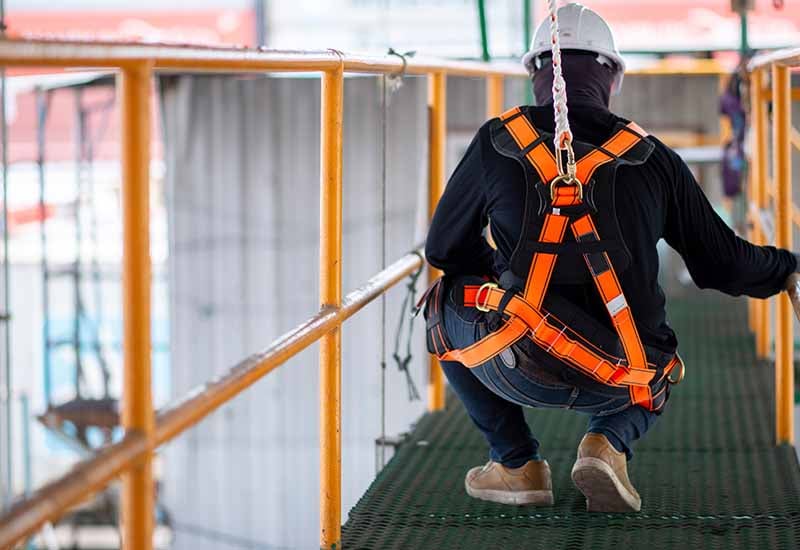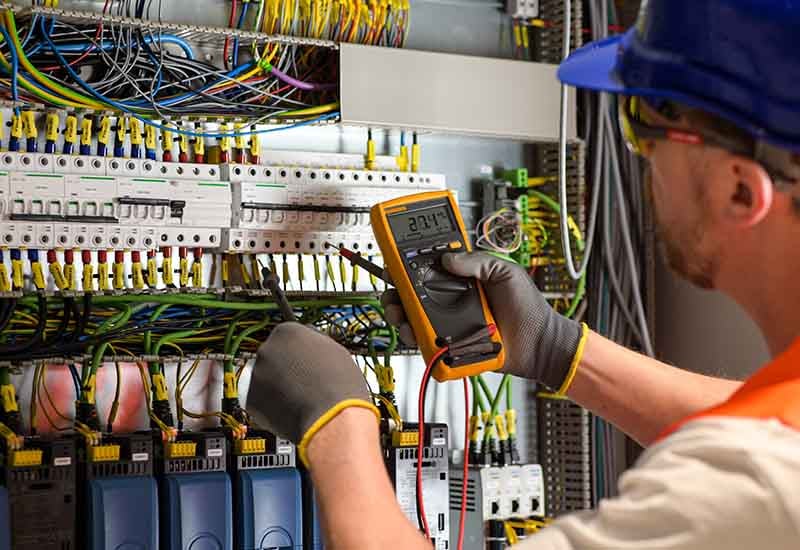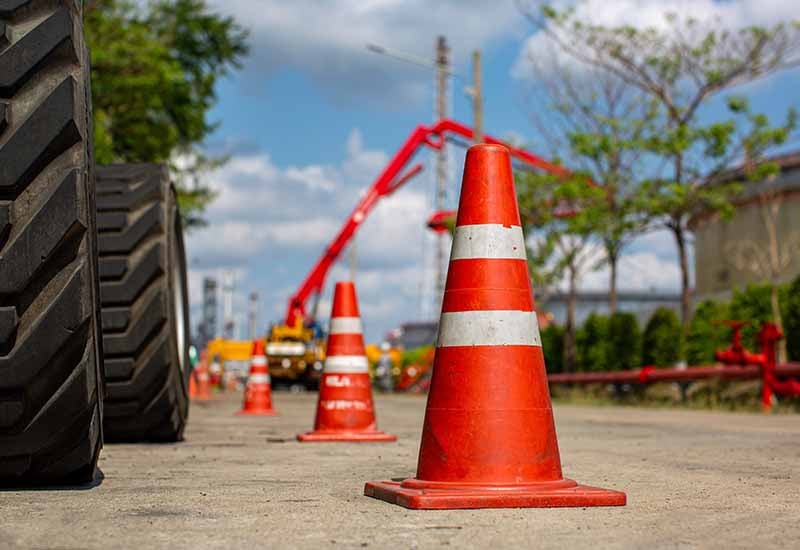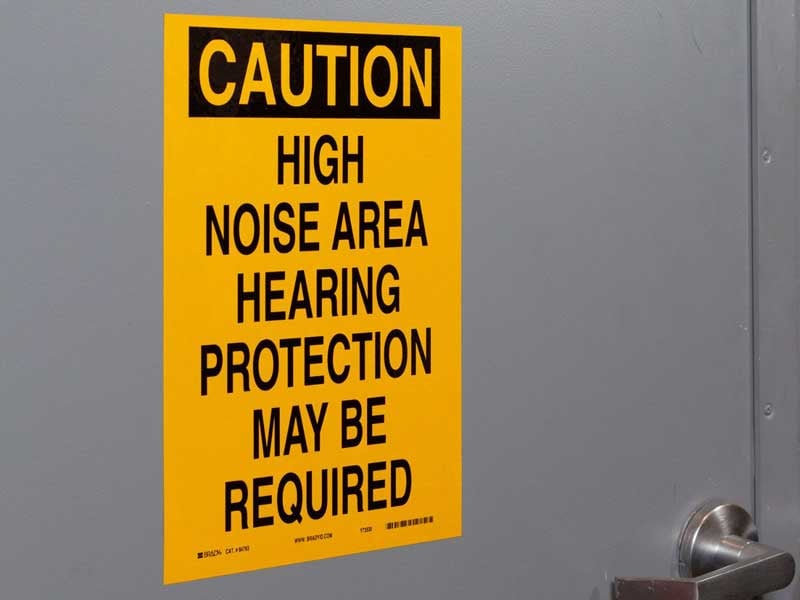Common Construction Hazards: Understanding and Mitigating Risks
Construction sites are dynamic and inherently dangerous environments. There are hazards everywhere, ranging from immediate threats to long-term damage. Addressing both categories is important to ensure worker safety and prevent deadly accidents.
Here are some of the most common construction hazards and strategies for their mitigation:
Fall Hazards
Falls, slips and trips consistently rank as a leading cause of injuries and fatalities in construction. According to the Bureau of Labor Statistics, in 2023, falls from ladders, scaffolds, roofs, and other high places accounted for 421 of the 1,075 construction fatalities.
There are certain basic steps you can take to prevent falls.
- Clearly mark fall hazards: Implement highly visible signage, guardrails, and barriers to alert workers to unprotected edges, openings (including skylights and trenches), and changes in elevation.
- Communicate proper safety procedures: Conduct regular safety briefings and provide comprehensive training on working at heights, emphasizing safe climbing, movement, and personal protective equipment (PPE) use.
- Supply and inspect PPE: Provide workers with all necessary PPE and ensure that they know how to use it. Regularly inspect harnesses, lanyards, snaphooks, and all other parts of the fall arrest equipment for damage. Replace any defective PPE immediately.
- Inspect scaffolding and ladders: Scaffolding must be erected, used, and dismantled according to strict safety guidelines, with daily inspections for stability and integrity. Ladders must be of the correct type for the job, placed on stable surfaces at the proper angle, and inspected for defects before every use. Improper ladder use and faulty scaffolding are among OSHA's most cited violations.

Electrical Hazards — Power Accident Prevention and Safety
The risk of electrocution is present in numerous areas of a construction site. Unmarked high-voltage areas, equipment with exposed wiring and uncontrolled energy sources can all lead to serious injuries or fatalities. Between 2003 and 2010, the construction industry accounted for the highest number of electrical fatalities (849) among all industries. To minimize these risks, prioritize electrical safety with clear communication.
- Identify and warn of electrical hazards: Use electrical hazard warning signs to clearly mark any potential sources of electrical danger. These labels should feature universally recognized symbols to indicate high voltage areas, exposed wires and potential shock hazards. Ensure these labels are prominently displayed near electrical panels, junction boxes and any areas with exposed wiring.
- Control and isolate energy sources: Implement a robust lockout tagout program to ensure that electrical equipment is de-energized before maintenance or repair work. Use lockout tags, padlocks and devices to prevent accidental energization and protect workers from potential electrocution.
- Ensure comprehensive electrical identification: Properly labeled circuits, panels and equipment with electrical labels not only enhance safety by providing critical information about voltage and potential hazards but also streamline maintenance and troubleshooting.
Construction sites can significantly reduce the risk of electrical accidents and create a safer, more productive working environment for everyone through these safety practices.

Dropped-Item Hazards
Objects falling from heights can cause severe injury or death to workers below. Take all necessary precautions.
- Review and enforce proper procedures: This includes securing tools and materials to prevent them from falling, using toe boards, debris nets, and catch platforms.
- Designate walking areas and provide falling-item protection: Establish exclusion zones and overhead protection where work is being conducted above. Hard hats are essential PPE in these areas.
Trip and Slip Hazards
These common incidents often lead to sprains, strains and fractures. Maintaining safe walkways is key.
- Clearly mark walkways: Delineate clear pathways to guide workers and ensure routes remain free of obstructions.
- Install proper lighting: Illuminate all areas so workers can identify and avoid potential hazards - especially in dimly-lit areas and during night shifts.
- Implement anti-slip measures: Apply anti-slip tape to slippery surfaces, stairs and ramps to provide additional traction.
- Keep walkways clear: Promptly remove debris, tools, electrical cords and other materials from all pathways and work areas. Uneven and wet surfaces can be the culprit of many trip and slip incidents, so practice good housekeeping.
Chemical Hazards
Construction workers routinely encounter a range of hazardous substances, from solvents and adhesives to paints and cleaning agents. Proper management and awareness are critical.
- Clearly identify all chemicals: All containers must be properly labeled with their contents and hazard warnings, compliant with OSHA's Hazard Communication Standard(opens in a new tab).
- Pipe marking: Clearly mark pipes carrying hazardous substances to ensure their contents and flow direction are known.
- Train safe handling and storage procedures: Workers must receive comprehensive training on the correct procedures for handling, storing and disposing of chemicals. Ensure that Safety Data Sheets (SDSs) are readily available and your employees know how to read them.
- Consider one-point lessons to keep training fresh: Short, focused training sessions can reinforce key safety messages and address specific chemical risks regularly.
- Prepare for spills: Have appropriate spill kits readily available and train workers on proper spill containment and cleanup procedures.

Mitigate common chemical hazards
Silica and asbestos are two of the most common hazardous materials construction workers encounter.
- Prevent silica inhalation: Crystalline silica, found in concrete, brick and stone, can cause severe lung disease (silicosis) when inhaled. PPE (respirators with proper fit testing) is crucial, alongside abatement methods like water suppression, local exhaust ventilation and wet cutting/grinding techniques.
- Mitigate asbestos exposure: Originally used for fire prevention, asbestos can still be found in many older buildings. Exposure to asbestos can cause severe respiratory illness and cancer. Specialized PPE and training are required for its safe handling and removal.
Heavy Equipment Hazards
Operating heavy machinery is fundamental to construction but carries significant risks.
Identify struck-by hazards
Workers can be seriously hurt or killed when struck by moving equipment, swinging loads or falling objects.
- Traffic management: Implement clear traffic signs, designated vehicle routes and separate pedestrian walkways.
- Blind spot management: Use spotters, mirrors and cameras to minimize blind spots around heavy equipment. High-visibility clothing is essential for all workers near operating machinery.
Caught-in/between hazards
Workers can be caught between equipment and stationary objects, or pulled into machinery parts.
- Properly mark restricted access areas: Clearly identify and enforce restricted access zones around operating machinery and pinch points.
- LOTO (Lockout/Tagout): Implement strict lockout/tagout procedures to prevent accidental equipment startup during maintenance or repair.
- Install pinch point signs: Mark areas where body parts could be caught or crushed by moving parts of machinery.

Noise Hazards and Body Strain Hazards
Prolonged exposure to excessive noise and repetitive physical tasks can lead to long-term health issues.
Noise Hazards
- Identify continuous noise hazards: Constant noise exposure from generators, heavy machinery and general site operations can lead to gradual, permanent hearing loss. OSHA mandates hearing protection for prolonged exposure at or above 85 dB.
- Beware of impulsive Noise: Sudden, loud noises from activities like pile driving or jackhammering can cause immediate and significant hearing damage. This damage can even happen from a single instance.
- Provide hearing protection and sound monitors: Provide appropriate hearing protection, like earplugs or earmuffs and use sound monitoring to identify high-noise areas. Mitigate loud noises with mufflers or install quieter equipment where feasible.
HAVS and Manual Handling
- Hand-Arm Vibration Syndrome (HAVS): HAVS is caused by prolonged use of vibrating hand tools, which can lead to circulatory and neurological damage. Protective gear, such as anti-vibration gloves, can help reduce damage risk.
- Strains and manual handling injuries: Improper lifting techniques, overexertion and repetitive motions account for a significant portion of non-fatal injuries. Train workers on proper lifting techniques, provide mechanical aids for heavy loads and conduct one-point lessons on ergonomic principles to minimize these common injuries.

Safety is Priority One
Proactively addressing these common construction hazards can significantly improve worker health and safety, ensuring everyone goes home at the end of each day. You can prioritize a safe workplace by supplying PPE, conducting proper training and establishing safe procedures for all employees.
Brady provides the products and services you need to help create a safer construction site.
Get in Touch